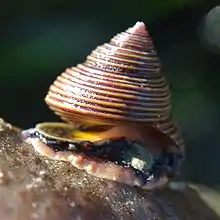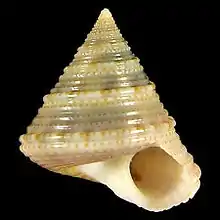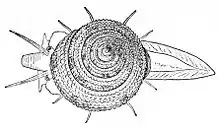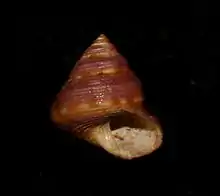Calliostoma
Calliostoma is a genus of small to medium-sized sea snails with gills and an operculum, marine gastropod molluscs within the family Calliostomatidae, the Calliostoma top snails (according to the taxonomy of Gastropoda by Bouchet & Rocroi (2005)). Previously this genus was placed within the family Trochidae. Calliostoma is the type genus of the family Calliostomatidae.
| Calliostoma | |
|---|---|
 | |
| A live individual of Calliostoma ligatum with the operculum showing at the back (on the left) | |
| Scientific classification | |
| Kingdom: | Animalia |
| Phylum: | Mollusca |
| Class: | Gastropoda |
| Subclass: | Vetigastropoda |
| Order: | Trochida |
| Superfamily: | Trochoidea |
| Family: | Calliostomatidae |
| Subfamily: | Calliostomatinae |
| Genus: | Calliostoma Swainson, 1840 |
| Type species | |
| Trochus conulus Linnaeus, 1758 | |
| Synonyms[1] | |
|
List
| |

The name of this genus is derived from the Greek words kallos (beautiful) and stoma (mouth), referring to the pearly aperture of the shell. The genus Calliostoma is known in fossil records from the Upper Cretaceous onwards.[2]
The distribution of this genus is worldwide, found mainly on hard substrates, although Japanese species have been found on sandy bottoms. These snails occur from shallow waters to bathyal depths.
The species in this genus are mainly herbivorous or feed on detritus,[3] although a few have been observed to be omnivorous (Keen, 1975) or even carnivorous, feeding on a wide range of algae and on animals belonging to various other invertebrate phyla.[4] The North Atlantic topshell Calliostoma occidentale has been reported to feed on coelenterates.[5]
Contrary to what is the case in most other top shells, Calliostoma deposits its eggs in gelatinous ribbons that are only fertilized after being deposited. The young emerge as small snails (Lebour, 1936) without passing through a free-living planktonic stage as a veliger larva.
Description
The rather thin, acute, coeloconoid (=approaching conical shape but with concave sides) shell is imperforate or rarely umbilicate. The whorls are smooth, often polished and spirally ridged or granular. The body whorl is angulated at the periphery. The aperture is quadrangular, sinuated at the base and slightly oblique. The columella is simple, usually ending anteriorly in a slight tooth.[6] The nucleus appears to be either dextral or sinistral indifferently.[7][8]
Species
Currently, Calliostoma is being treated in WoRMS as a broad genus. It is expected to be broken up and (some) subgenera will be elevated to the status of genus. At this moment (2013), information is too fragmentary to assign all species in a revised genus.
Species within the genus Calliostoma include:[1]
- Calliostoma aculeatum G.B. Sowerby III, 1912
- Calliostoma adelae Schwengel, 1951
- Calliostoma admirandum E.A. Smith, 1906
- Calliostoma adspersum (Philippi, 1851)
- Calliostoma aequisculptum Carpenter, 1865
- Calliostoma africanum Bartsch, 1915
- Calliostoma agalma Schwengel, 1942
- Calliostoma agrigentinum Coen, 1936
- Calliostoma aikeni Lussi, 2014
- Calliostoma akoya Kuroda in Ikebe, 1942
- Calliostoma alboregium Azuma, 1961
- Calliostoma alisi Marshall, 1995
- Calliostoma allporti (Tenison-Woods, 1876)
- Calliostoma altena Knudsen, 1970
- Calliostoma alternatum Millet, 1865
- Calliostoma alternum Quinn, 1992
- Calliostoma amamiense (Sakurai, 1994)
- Calliostoma anderssoni Strebel, 1908
- Calliostoma angolense Boyer, 2006
- Calliostoma annulatum (Lightfoot, 1786)
- Calliostoma anseeuwi Poppe, Tagaro & Dekker, 2006
- Calliostoma antipodense Marshall, 1995
- Calliostoma antonii (Koch in Philippi, 1843)
- Calliostoma apicisuperi S.-I Huang & I.-F. Fu, 2019
- Calliostoma apicinum Dall, 1881
- Calliostoma apicisuperi S.-I Huang & I-F. Fu, 2019
- Calliostoma aporia Vilvens, 2009
- Calliostoma aprosceptum Vilvens, 2009
- Calliostoma argentum Quinn, 1992
- Calliostoma arx Vilvens, 2005
- Calliostoma atlantis Clench & Aguayo, 1940
- Calliostoma aulicum Quinn, 1992
- Calliostoma aupourianum Marshall, 1995
- Calliostoma aurora Dall, 1888
- Calliostoma axelolssoni Quinn, 1992
- Calliostoma babelicum Habe, 1961
- Calliostoma baccatum Millet, 1865
- Calliostoma bairdii Verrill & Smith, 1880
- Calliostoma barbouri Clench & Aguayo, 1946
- Calliostoma basulense Poppe, Tagaro & Vilvens, 2014
- Calliostoma belauense Okutani & Kurata, 1998
- Calliostoma bellatrix Willan, 2002
- Calliostoma benedicti Dall, 1889
- Calliostoma benthicola (Dell, 1950)
- Calliostoma bermudense Quinn, 1992
- Calliostoma bernardi J. H. McLean, 1984
- Calliostoma biangulatum Landau, Van Dingenen & Ceulemans, 2017
- Calliostoma bigelowi Clench & Aguayo, 1938
- Calliostoma blacki (Powell, 1950)
- Calliostoma bonita Strong, Hanna & Hertlein, 1933
- Calliostoma boscianum Brongniart, 1823
- Calliostoma boucheti Marshall, 1995
- Calliostoma brunneopictum Quinn, 1992
- Calliostoma brunneum (Dall, 1881)
- Calliostoma bullatum (Philippi, 1844)
- Calliostoma bullisi Clench & Turner, 1960
- Calliostoma canaliculatum (Sasao & Habe, 1973) (double entry)
- Calliostoma canaliculatum (Lightfoot, 1786)
- Calliostoma carcellesi Clench & Aguayo, 1940
- Calliostoma caribbechinatum Landau, Van Dingenen & Ceulemans, 2017
- Calliostoma caroli (Dautzenberg, 1927)
- Calliostoma cheni (Dong, 2002)
- Calliostoma chesterfieldense Marshall, 1995
- Calliostoma chinoi Poppe, Tagaro & Dekker, 2006
- Calliostoma chlorum Vilvens, 2005
- Calliostoma chuni (Martens, 1903)
- Calliostoma cinctellum Dall, 1889
- Calliostoma circumcinctum Dall, 1881
- Calliostoma circus Barnard, 1969
- Calliostoma cleopatra (Locard, 1896)
- Calliostoma cnidophilum Quinn, 1992
- Calliostoma cochlias Vilvens, 2009
- Calliostoma columnarium Hedley & May, 1908
- Calliostoma comptum A. Adams, 1855
- Calliostoma connyae Poppe, Tagaro & Vilvens, 2014
- Calliostoma consimile (E. A. Smith, 1881)
- Calliostoma consobrinum (Powell, 1958)
- Calliostoma consors (Lischke, 1872)
- †Calliostoma contractum (Millet, 1865)
- Calliostoma conulus (Linnaeus, 1758)
- Calliostoma coppingeri (E. A. Smith, 1880)
- Calliostoma coronatum Quinn, 1992
- Calliostoma crassicostatum Schepman, 1908
- Calliostoma cristatum Marshall, 1995
- Calliostoma crossleyae E. A. Smith, 1910
- Calliostoma cubense Quinn, 1992
- Calliostoma cyrtoida Gofas & Hoffman, 2020
- Calliostoma debile Quinn, 1992
- Calliostoma decipiens (Guppy, 1867)
- Calliostoma dedonderi Vilvens, 2000
- Calliostoma delonguevilleae Vilvens & Swinnen, 2017
- Calliostoma dentatum Quinn, 1992
- Calliostoma depictum Dall, 1927
- Calliostoma diadematum Marshall, 1995
- Calliostoma diaphoros Vilvens, 2009
- Calliostoma doncorni Kay, 1979
- Calliostoma duricastellum Melvill, 1898
- Calliostoma echinatum Dall, 1881
- Calliostoma elegantulum (A. Adams, 1853)
- Calliostoma eminens Marshall, 1995
- Calliostoma emmanueli Vilvens, 2000
- Calliostoma escondidum Poppe, Tagaro & Vilvens, 2014
- Calliostoma euglyptum (A. Adams, 1855)
- Calliostoma eximium (Reeve, 1843)
- Calliostoma fascinans Schwengel & McGinty, 1942
- Calliostoma fernandesi Rolán & Monteiro, 2006
- Calliostoma fernandezi Princz, 1978
- Calliostoma filiareginae (Sakurai, 1994)
- Calliostoma fonki (Philippi, 1860)
- Calliostoma formosense E.A. Smith, 1907
- †Calliostoma formosissimum (G. Seguenza, 1876)
- Calliostoma foveauxanum (Dell, 1950)
- Calliostoma fragum (Philippi, 1848)
- Calliostoma freiwaldi Gofas & Hoffman, 2020
- Calliostoma frumari García, 2007
- Calliostoma fucosum Quinn, 1992
- Calliostoma funiculare Melvill, 1906
- Calliostoma funiculatum Ardovini, 2011
- Calliostoma galea (Sakurai, 1994)
- Calliostoma gavaldoni Vilvens, 2009
- Calliostoma gemmosum (Reeve, 1842)
- Calliostoma gemmulatum Carpenter, 1864
- Calliostoma gendalli Marshall, 1979
- Calliostoma gibbsorum Marshall, 1995
- Calliostoma gloriosum Dall, 1871
- Calliostoma gordanum McLean, 1970
- Calliostoma granti (Powell, 1931)
- Calliostoma granulatum (Born, 1778)
- †Calliostoma gratiosum (Millet, 1865)
- Calliostoma grimaldii (Dautzenberg &H. Fischer, 1896)
- Calliostoma grohi Stratmann & Stahlschmidt, 2007
- Calliostoma gualterianum (Philippi, 1848)
- Calliostoma gubbiolii Nofroni, 1984
- Calliostoma guerreroense Tuskes & McGowan-Tuskes, 2019
- Calliostoma guesti Quinn, 1992
- Calliostoma guphili Poppe, 2004
- Calliostoma haapaiense Vilvens, 2014
- Calliostoma hajimeanum Yoshida, 1948
- Calliostoma haliarchus (Melvill, 1889)
- Calliostoma halibrectum Dall, 1927
- Calliostoma hassler Clench & Aguayo, 1939
- Calliostoma hayamanum (Kuroda & Habe, 1971 in Kuroda, Habe & Oyama, 1971)
- Calliostoma hayashii Shikama, 1977
- Calliostoma hedleyi Pritchard & Gatliff, 1902
- Calliostoma hematomenon Vilvens, 2014
- Calliostoma hendersoni Dall, 1927
- Calliostoma herberti Vilvens, 2014
- Calliostoma hernandezi Rubio & Gubbioli, 1993
- Calliostoma heros Marshall, 1995
- Calliostoma heugteni Vilvens & Swinnen, 2003
- Calliostoma hexalyssion Vilvens, 2009
- Calliostoma hilare Quinn, 1992
- Calliostoma hirondellei (Dautzenberg & H. Fischer, 1896)
- Calliostoma hirtum Quinn, 1992
- Calliostoma houarti Vilvens, 2000
- Calliostoma houbricki Marshall, 1995
- Calliostoma hungi S.-I Huang & I.-F. Fu, 2019
- Calliostoma imperiale Kosuge, 1979
- Calliostoma incertum (Reeve, 1863)
- Calliostoma indiana Dall, 1889
- Calliostoma inopinatum Dautzenberg, 1911 (taxon inquirendum)
- Calliostoma insigne Olsson, 1971
- Calliostoma insignis Olsson, 1971
- Calliostoma interruptus (Wood, 1828)
- Calliostoma iridescens G.B. Sowerby III, 1903
- Calliostoma iridium Dall, 1896
- Calliostoma iris (Kuroda & Habe in Habe, 1961)
- Calliostoma irisans Strebel, 1905
- Calliostoma iwamotoi Ikebe, 1942
- Calliostoma iwaotakii (Azuma, 1961)
- Calliostoma jackelynae Bozzetti, 1997
- Calliostoma jacquelinae McLean, 1970
- Calliostoma jamiesoni Marshall, 1995
- Calliostoma javanicum (Lamarck, 1822)
- Calliostoma jeanneae Clench & Turner, 1960
- Calliostoma joanneae Olsson, 1971
- Calliostoma jucundum (Gould, 1849)
- Calliostoma jujubinum (Gmelin, 1791)
- Calliostoma kampsa Dall, 1927
- Calliostoma kanakorum Marshall, 2001
- Calliostoma katherina (Iredale, 1936)
- Calliostoma katoi (Sakurai, 1994)
- Calliostoma katorii Poppe, Tagaro & Goto, 2018
- Calliostoma katsunakamai Kosuge, 1998
- Calliostoma keenae McLean, 1970
- Calliostoma kiiense Ikebe, 1942
- Calliostoma kochi Pallary, 1902
- Calliostoma koma (Shikama & Habe, 1965)
- Calliostoma kurodai (Azuma, 1975)
- Calliostoma laugieri (Payraudeau, 1826)
- Calliostoma layardi Sowerby III, 1897
- Calliostoma leanum (C. B. Adams, 1852)
- Calliostoma legrandi (Tenison-Woods, 1876)
- Calliostoma lepton Vilvens, 2012
- Calliostoma leptophyma (Dautzenberg & H. Fischer, 1896)
- Calliostoma lequementorum Poppe & Tagaro, 2019
- Calliostoma levibasis (Kuroda & Habe, 1971 in Kuroda, Habe & Oyama)
- Calliostoma ligatum (Gould, 1849)
- Calliostoma lithocolletum (Dautzenberg, 1925)
- Calliostoma lividum Dautzenberg, 1927
- Calliostoma lui S.-I Huang & I.-F. Fu, 2019
- Calliostoma lusitanicum F. Nordsieck & García-Talavera, 1979 (taxon inquirendum)
- Calliostoma madagascarense Vilvens, Nolf & Verstraeten, 2004
- Calliostoma madatechnema Vilvens, 2014
- Calliostoma maekawai Poppe, Tagaro & Goto, 2018
- Calliostoma magaldii Caldini & Prado, 1998
- Calliostoma malaita Vilvens, 2009
- Calliostoma manesol Huang & Fu, 2015
- Calliostoma margaretae Aiken & Seccombe, 2019
- Calliostoma margaritissimum (Habe & Okutani, 1968)
- Calliostoma mariae Poppe, Tagaro & Dekker, 2006
- Calliostoma marionae Dall, 1906
- Calliostoma marisflavi Huang & Fu, 2015
- Calliostoma marshalli Lowe, 1935
- Calliostoma maui Marshall, 1995
- Calliostoma maurolici (G. Seguenza, 1876)
- Calliostoma mcleani Shasky & Campbell, 1964
- Calliostoma melliferum Cavallari & Simone, 2018
- Calliostoma megaloprepes (Tomlin, 1948)
- Calliostoma melliferum Cavallari & Simone, 2018
- Calliostoma mesemorinon Vilvens, 2014
- Calliostoma metabolicum Vilvens, 2005
- Calliostoma metivieri Marshall, 1995
- Calliostoma mikikoae (Kosuge & Oh-Ishi, 1970)
- Calliostoma militare Ihering, 1907
- † Calliostoma milletechinatum Landau, Ceulemans & Van Dingenen, 2018
- †Calliostoma milletigranum Landau, Van Dingenen & Ceulemans, 2017
- Calliostoma milneedwardsi (Locard, 1898)
- †Calliostoma miotorulosum Landau, Van Dingenen & Ceulemans, 2017
- †Calliostoma miotumidum Landau, Van Dingenen & Ceulemans, 2017
- Calliostoma modestulum Strebel, 1908
- Calliostoma moebiusi Strebel, 1905
- Calliostoma monikae Stratmann & Schwabe, 2007
- Calliostoma moscatellii Quinn, 1992
- Calliostoma multiliratum (Sowerby II, 1875)
- Calliostoma muriellae Vilvens, 2001
- Calliostoma nakamigawai (Sakurai, 1994)
- Calliostoma nanshaense Dong, 2002
- Calliostoma necopinatum Marshall, 1995
- Calliostoma nepheloide Dall, 1913
- Calliostoma nobile (Hirase, 1922)
- Calliostoma nordenskjoldi Strebel, 1908
- Calliostoma normani (Dautzenberg & H. Fischer, 1897)
- Calliostoma nudiusculum (Martens, 1881)
- † Calliostoma nodulosum Solander, 1766 [9]
- Calliostoma nudum (Philippi, 1845)
- Calliostoma obesulum (Locard, 1898)
- Calliostoma occidentale (Mighels & C. B. Adams, 1842)
- Calliostoma ocellatum (Reeve, 1863)
- Calliostoma opalinum (Kuroda & Habe in Kuroda, Habe & Oyama, 1971)
- Calliostoma oregon Clench & Turner, 1960
- Calliostoma orion Dall, 1889
- Calliostoma ornatum (Lamarck, 1822)
- Calliostoma osbornei Powell, 1926
- Calliostoma otukai Ikebe, 1942
- †Calliostoma pagodulum (Millet, 1865)
- Calliostoma palmeri Dall, 1871
- Calliostoma paradigmatum Marshall, 1995
- Calliostoma parvajuba Vilvens, 2014
- Calliostoma paucicostatum Kosuge, 1984
- Calliostoma pellucidum (Valenciennes, 1846)
- Calliostoma penniketi Marshall, 1995
- Calliostoma peregrinum Marshall, 1995
- Calliostoma perfragile G.B. Sowerby III, 1903
- Calliostoma periglyptum Marshall, 1995
- Calliostoma pertinax Marshall, 1995
- Calliostoma philippei Poppe, 2004
- Calliostoma picturatum (A. Adams, 1851)
- Calliostoma pillsburyae Olsson, 1971
- † Calliostoma planospirum (Millet, 1865)
- Calliostoma platinum Dall, 1890
- Calliostoma polysarkon Vilvens, 2014
- Calliostoma poppei Vilvens, 2000
- Calliostoma poupineli (Montrouzier in Souverbie & Montrouzier, 1875)
- Calliostoma problematicum (Kuroda & Habe in Kuroda, Habe & Oyama, 1971)
- Calliostoma psyche Dall, 1888
- Calliostoma pulchrum (C. B. Adams, 1850)
- Calliostoma punctulatum (Martyn, 1784)
- Calliostoma purpureum Quinn, 1992
- Calliostoma pyrron Vilvens, 2014
- Calliostoma quadricolor Schepman, 1908
- Calliostoma regale Marshall, 1995
- Calliostoma rema Strong, Hanna & Hertlein, 1933
- Calliostoma richeri Marshall, 1995
- Calliostoma roseolum Dall, 1881
- Calliostoma rosewateri Clench & Turner, 1960
- Calliostoma rota Quinn, 1992
- Calliostoma rubroscalptum Lee & Wu, 1998
- Calliostoma rude Quinn, 1992
- Calliostoma rufomaculatum Schepman, 1908
- Calliostoma sagamiense (Ishida & Uchida, 1977)
- Calliostoma sakashitai (Sakurai, 1994)
- Calliostoma sanjaimense McLean, 1970
- Calliostoma santacruzanum McLean, 1970
- Calliostoma sapidum Dall, 1881
- Calliostoma sarcodum Dall, 1927
- Calliostoma sayanum Dall, 1889
- Calliostoma scalenum Quinn, 1992
- Calliostoma schroederi Clench & Aguayo, 1938
- Calliostoma scobinatum (A. Adams in Reeve, 1863)
- Calliostoma scotti Kilburn, 1973
- Calliostoma scurra Quinn, 1992
- Calliostoma selectum (Dillwyn, 1817)
- Calliostoma semisuave Quinn, 1992
- Calliostoma serratulum Quinn, 1992
- Calliostoma shinagawaense (Tokunaga, 1906)
- Calliostoma simodense Ikebe, 1942
- Calliostoma simplex Schepman, 1908
- Calliostoma simulans Marshall, 1994
- Calliostoma soyoae Ikebe, 1942
- Calliostoma spectabile (A. Adams, 1855)
- Calliostoma spesa J.-L. Zhang, Wei & S.-P. Zhang, 2018
- Calliostoma splendens Carpenter, 1864
- Calliostoma springeri (Clench & Turner, 1960)
- Calliostoma stirophorum (Watson, 1879)
- Calliostoma strobilos Vilvens, 2005
- Calliostoma subalboroseum Vilvens, 2014
- Calliostoma sublaeve E.A. Smith, 1895
- Calliostoma suduirauti Bozzetti, 1997
- Calliostoma sugitanii (Sakurai, 1994)
- Calliostoma supragranosum Carpenter, 1864
- Calliostoma swinneni Poppe, Tagaro & Dekker, 2006
- Calliostoma syungokannoi Kosuge, 1998
- Calliostoma takaseanum (Okutani, 1972)
- Calliostoma takujii Kosuge, 1986
- Calliostoma tampaense (Conrad, 1846)
- Calliostoma tenebrosum Quinn, 1992
- Calliostoma textor Vilvens, 2014
- Calliostoma thachi Alf & Stratmann, 2007
- Calliostoma thrincoma Melvill & Standen, 1903
- Calliostoma ticaonicum (A. Adams, 1851)
- Calliostoma tigris (Gmelin, 1791)
- Calliostoma titanium McLean, 1984
- Calliostoma tittarium Dall, 1927
- Calliostoma tornatum (Röding, 1798)
- Calliostoma torrei Clench & Aguayo, 1940
- Calliostoma tosaense (Kuroda & Habe in Habe, 1961)
- Calliostoma toshiharui Kosuge, 1997
- Calliostoma trachystum Dall, 1927
- Calliostoma tranquebaricum (Röding, 1798)
- Calliostoma tricolor Gabb, 1865
- Calliostoma triporcatum (Locard, 1898)
- Calliostoma tropis Vilvens, 2009
- Calliostoma trotini Poppe, Tagaro & Dekker, 2006
- Calliostoma tsuchiyai (Kuroda & Habe in Kuroda, Habe & Oyama, 1971)
- Calliostoma tumidosolidum Vilvens, 2014
- Calliostoma tupinamba Dornellas, 2012
- Calliostoma turbinum Dall, 1896
- Calliostoma turnerarum (Powell, 1964)
- †Calliostoma umbellum (Millet, 1865)
- Calliostoma unicum (Dunker, 1860)
- Calliostoma uranipponense (Okutani, 1969)
- Calliostoma valkuri Cavallari, Salvador, Dornellas & Simone, 2019
- Calliostoma variegatum Carpenter, 1864
- Calliostoma vaubanoides Vilvens, 2014
- Calliostoma vaubani Marshall, 1995
- Calliostoma veleroae McLean, 1970
- Calliostoma venustum (Dunker, 1871)
- †Calliostoma vibrayanum (Dollfus & Dautzenberg, 1886)
- Calliostoma vicdani Kosuge, 1984
- Calliostoma vilvensi Poppe, 2004
- Calliostoma vinosum Quinn, 1992
- Calliostoma virescens Coen, 1933
- Calliostoma virgo Schepman, 1908
- Calliostoma viscardii Quinn, 1992
- Calliostoma waikanae Oliver, 1926
- Calliostoma xanthos Marshall, 1995
- Calliostoma xylocinnamomum Vilvens, 2005
- Calliostoma yucatecanum Dall, 1881
- Calliostoma zietzi Verco, 1905
- Calliostoma zizyphinum (Linnaeus, 1758)
- Species brought into synonymy
- [1]
- Calliostoma adamsi Brazier, 1895: synonym of Calliostoma comptum A. Adams, 1855
- Calliostoma adamsi Pilsbry, 1889: synonym of Astele subcarinata Swainson, 1855
- Calliostoma affinis Dall, 1872: synonym of Calliostoma unicum (Dunker, 1860)
- Calliostoma albolineatum Turton, 1932: synonym of Calliostoma ornatum (Lamarck, 1822)
- Calliostoma alertae Marshall, 1995: synonym of Otukaia blacki (Dell, 1956)
- Calliostoma australis Broderip, 1835: synonym of Astele rubiginosa (Valenciennes, 1846)
- Calliostoma belauensis Okutani & Kurata, 1998: synonym of Calliostoma belauense Okutani & Kurata, 1998
- Calliostoma bisculptum E.A. Smith: synonym of Cantharidus bisculptus E.A. Smith
- Calliostoma bularra (Garrard, 1961): synonym of Astele bularra Garrard, 1961
- Calliostoma burnupi E. A. Smith, 1899: synonym of Dactylastele burnupi (E.A. Smith, 1899)
- Calliostoma calliope Cotton & Godfrey, 1938: synonym of Astele ciliaris (Menke, 1843)
- Calliostoma cancellatum Schepman, 1908: synonym of Perrinia cancellata (Schepman, 1908)
- Calliostoma carnicolor Preston, 1907: synonym of Calliostoma selectum (Dillwyn, 1817)
- Calliostoma cecillei Nomura & Hatai, 1935: synonym of Calliostoma unicum (Dunker, 1860)
- Calliostoma chilenum Rehder, 1971: synonym of Otukaia chilena (Rehder, 1971)
- Calliostoma cipangoanum Yokoyama, 1920: synonym of Calliostoma shinagawaense (Tokunaga, 1906)
- Calliostoma conuloide (Lamarck, 1822): synonym of Calliostoma zizyphinum (Linnaeus, 1758)
- Calliostoma convexa Turton, 1932: synonym of Calliostoma africanum Bartsch, 1915
- Calliostoma corbis Dall, 1889: synonym of Mirachelus corbis (Dall, 1889)
- Calliostoma deceptum E.A. Smith, 1899: synonym of Laetifautor deceptus (E.A. Smith, 1899)
- Calliostoma dubium (Philippi, 1844): synonym of Calliostoma conulus (Linnaeus, 1758)
- Calliostoma elegans (Habe, 1960): synonym of Laetifautor elegans Habe, 1960
- Calliostoma eucosmia Bartsch, 1915: synonym of Calliostoma ornatum (Lamarck, 1822)
- Calliostoma excellens Thiele, 1930: synonym of Astele similaris (Reeve, 1863)
- Calliostoma expansum Schepman, 1908: synonym of Enida japonica A. Adams, 1860
- Calliostoma fernandesi Boyer, 2006: synonym of Calliostoma angolensis Boyer, 2006
- Calliostoma formosensis E.A. Smith, 1907: synonym of Calliostoma formosense E.A. Smith, 1907
- Calliostoma formosum (McAndrew & Forbes, 1847): synonym of Calliostoma occidentale (Mighels & C. B. Adams, 1842)
- Calliostoma formosum Carpenter, 1864: synonym of Calliostoma gemmulatum Carpenter, 1864
- Calliostoma glaucophaos Barnard, 1963: synonym of Minolia glaucophaos (Barnard, 1963)
- Calliostoma hungerfordi Sowerby, 1888: synonym of Calliostoma consors (Lischke, 1872)
- Calliostoma ikukoae (Sakurai, 1994): synonym of Otukaia kiheiziebisu (Otuka, 1939)
- Calliostoma ilhabelensis Prado, 2003: synonym of Calliostoma tupinamba Dornellas, 2012
- Calliostoma imperialis Kosuge, 1979: synonym of Calliostoma imperiale Kosuge, 1979
- Calliostoma ishianum Yokoyama, 1926: synonym of Calliostoma multiliratum (Sowerby II, 1875)
- Calliostoma kiheiziebisu Otuka, 1939: synonym of Otukaia kiheiziebisu (Otuka, 1939)
- Calliostoma kopua Marshall, 1995: synonym of Selastele kopua (Marshall, 1995)
- Calliostoma limatulum Marshall, 1995: synonym of Selastele limatulum B. A. Marshall, 1995
- Calliostoma madagascarensis Vilvens, Nolf & Verstraeten, 2004: synonym of Calliostoma madagascarense Vilvens, Nolf & Verstraeten, 2004
- Calliostoma marginata (Schepman, 1909): synonym of Fluxinella marginata (Schepman, 1909)
- Calliostoma monodon Schepman, 1908: synonym of Ancistrobasis monodon (Schepman, 1908)
- Calliostoma nanshaensis (sic): synonym of Calliostoma nanshaense Dong, 2002
- Calliostoma nevilli G.B. Sowerby III, 1905: synonym of Dactylastele nevilli (Sowerby, 1905)
- Calliostoma nigromaculatum Schepman, 1908: synonym of Perrinia nigromaculata (Schepman, 1908)
- Calliostoma onustum Odhner, 1924: synonym of Selastele onustum B. A. Marshall, 1995
- Calliostoma ornata [sic]: synonym of Calliostoma ornatum (Lamarck, 1822)
- Calliostoma pagoda Oliver, 1926: synonym of Calliostoma selectum (Dillwyn, 1817)
- Calliostoma papillosa (Da Costa, 1778): synonym of Calliostoma granulatum (Born, 1778)
- Calliostoma plambralum Spry, 1961: synonym of Jujubinus interruptus (Wood, 1828)
- Calliostoma polychroma (A. Adams, 1851): synonym of Cantharidus polychroma (A. Adams, 1851)
- Calliostoma poupineli (Montrouzier in Souverbie & Montrouzier, 1875): synonym of Calliostoma comptum A. Adams, 1855
- Calliostoma purpureocinctum Hedley, 1894: synonym of Calliostoma comptum A. Adams, 1855
- Calliostoma regalis (Verrill & S. Smith, 1880): synonym of Calliotropis regalis (Verrill & Smith, 1880)
- Calliostoma retiarium Hedley & May, 1908: synonym of Selastele retiarium (Hedley & May, 1908)
- Calliostoma rossica (Dall, 1919): synonym of Margarites rossicus Dall, 1919
- Calliostoma rubropunctatum (A. Adams, 1851): synonym of Laetifautor rubropunctatus (A. Adams, 1851)
- Calliostoma rubroscalpta Lee & Wu, 1998: synonym of Calliostoma rubroscalptum Lee & Wu, 1998
- Calliostoma sagamianum Yokoyama, 1920: synonym of Calliostoma consors (Lischke, 1872)
- Calliostoma sowerbyi Pilsbry, 1889: synonym of Calliostoma haliarchus (Melvill, 1889)
- Calliostoma spinulosum Tate, 1893: synonym of Laetifautor spinulosum (Tate, 1893)
- Calliostoma squamicarinatum Schepman, 1908: synonym of Perrinia squamicarinata (Schepman, 1908)
- Calliostoma stenomphalumG. B. Sowerby III, 1890): synonym of Jujubinus suarezensis fultoni (G. B. Sowerby III, 1890) †
- Calliostoma striatum (Linnaeus, 1758): synonym of Jujubinus striatus (Linnaeus, 1758)
- Calliostoma suturale (Philippi, 1836): synonym of Callumbonella suturalis (Philippi, 1836)
- Calliostoma tiara auct. non Watson, 1879: synonym of Lamellitrochus inceratus Quinn, 1991
- Calliostoma trepidum Hedley, 1907: synonym of Laetifautor deceptus (E.A. Smith, 1899)
- Calliostoma undulatum Finlay, 1923: synonym of Calliostoma pellucidum (Valenciennes, 1846)
- Calliostoma vincentae Kaicher 1986: synonym of Callumbonella suturalis (Philippi, 1836)
Gallery
 Drawing of a dorsal view of a living animal of Calliostoma bairdii dredged in the Atlantic Ocean at a depth of from 100 m to 1170 m
Drawing of a dorsal view of a living animal of Calliostoma bairdii dredged in the Atlantic Ocean at a depth of from 100 m to 1170 m Rare purple beaded specimen of Calliostoma supragranosum found subtidally in Southern California
Rare purple beaded specimen of Calliostoma supragranosum found subtidally in Southern California
References
- Calliostoma Swainson, 1840. Retrieved through: World Register of Marine Species on 30 October 2010.
- Shimer & Shrock (1944). Index fossils of North America.
- Clench W. & Turner R. (1960). "The genus Calliostoma in the western Atlantic". Johnsonia 4(40) :1-80.
- Perron, F. E. (1975). "Carnivorous Calliostoma (Prosobranchia: Trochidae) from the northeastern Pacific". Veliger. 18: 52–54.
- Perron, Frank E.; Turner R. D. (1978). "The feeding behaviour and diet of Calliostoma occidentale, a coelenterate-associated prosobranch gastropod". Journal of Molluscan Studies. 44 (1): 100–103. Retrieved 20 May 2010.
- Tryon (1889), Manual of Conchology XI, Academy of Natural Sciences, Philadelphia
- Dall W. H. 1889. Reports on the results of dredging, under the supervision of Alexander Agassiz, in the Gulf of Mexico (1877–78) and in the Caribbean Sea (1879–80), by the U.S. Coast Survey Steamer "Blake", Lieut.-Commander C.D. Sigsbee, U.S.N., and Commander J.R. Bartlett, U.S.N., commanding. XXIX. Report on the Mollusca. Part 2, Gastropoda and Scaphopoda. Bulletin of the Museum of Comparative Zoölogy at Harvard College 18: 1–492, pls. 10–40
- Swainson, W. 1840. A treatise on malacology, or shells and shell-fish; London
- Europeana: Calliostoma nodulosum
- Vilvens C. (2012) New species and new records of Seguenzioidea and Trochoidea (Gastropoda) from French Polynesia. Novapex 13(1): 1–23. [10 March 2012] page(s): 18
Further reading
- Marshall, B.A. (1995). "A revision of the recent Calliostoma species of New Zealand". The Nautilus. 108: 83–127.
- Quinn, J.F. Jr. (1992). "New species of Calliostoma and notes on some poorly known species from the Western Atlantic". The Nautilus. 106: 77–114.
- Rosenberg G. (2005). "Malacolog 4.1.0: : A database of Western Atlantic Marine Mollusca". Archived from the original on 24 September 2015. Retrieved 18 March 2009.
- Williams, S.T.; K.M. Donald; H.G. Spencer; T. Nakano (March 2010). "Molecular systematics of the marine gastropod families Trochidae and Calliostomatidae (Mollusca: Superfamily Trochoidea)". Molecular Phylogenetics and Evolution. 3. 54 (3): 783–809. doi:10.1016/j.ympev.2009.11.008. PMID 19919851.
- Vilvens C. (2009). New species and new records of Calliostomatidae (Gastropoda: Trochoidea) from New Caledonia and Solomon Islands. Novapex 10(4): 125-163
